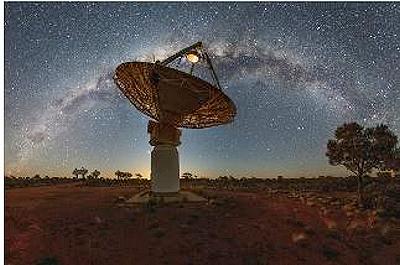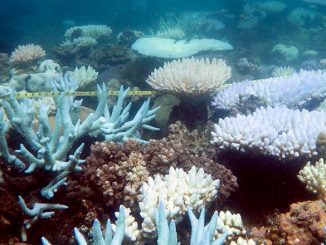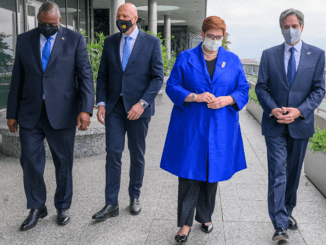
PERTH, Australia, December 1, 2020 (ENS) – A radio telescope in the outback of Western Australia is creating a new atlas of the universe at astonishing speed, mapping some three million galaxies in just 300 hours. The Australian Square Kilometre Array Pathfinder, ASKAP, telescope conducts a survey that’s like a Google map of the universe where most of the millions of points on the map are distant galaxies – at least a million of which humans have never seen before.
CSIRO Chief Executive Dr. Larry Marshall said ASKAP brings together world-class infrastructure with scientific and engineering expertise to unlock the deepest secrets of the universe.

“ASKAP is applying the very latest in science and technology to age-old questions about the mysteries of the universe and equipping astronomers around the world with new breakthroughs to solve their challenges,” he said.
The telescope’s key feature is its wide field of view, generated by new CSIRO-designed receivers, that enable ASKAP to take panoramic pictures of the sky in amazing detail.
ASKAP is a synthesis array consisting of 36 dish antennas, each 12 meters in diameter, spread out across a six-kilometer area using novel technology to achieve the extremely high survey speed.
“It’s all enabled by innovative receivers developed by CSIRO that feature phased array feed technology, which see ASKAP generate more raw data at a faster rate than Australia’s entire internet traffic,” Marshall explained.
“In a time when we have access to more data than ever before, ASKAP and the supercomputers that support it are delivering unparalleled insights and wielding the tools that will underpin our data-driven future to make life better for everybody,” he said.
At the start of the project back in 2009, CSIRO searched all over the country for a place to build a world-class radio astronomy observatory. The location had to be remote and far from human-caused radio interference, to ensure quietness for these instruments to detect radio waves traveling from billions of light years away. It also needed to be somewhere accessible for construction and observatory management.
CSIRO found the perfect spot in the Murchison area of Western Australia, 700 km northeast of Perth in traditional Wajarri Yamatji country.

CSIRO acknowledges the Wajarri Yamaji as the traditional owners of the MRO site. Since signing an agreement in 2009, the Wajarri Yamatji people and CSIRO have been engaged in a partnership as part of the ASKAP telescope project, located at the Murchison Radio-astronomy Observatory, MRO, on Wajarri Yamatji land.
Using ASKAP at CSIRO’s Murchison Radio-astronomy Observatory, the survey team observed 83 percent of the entire sky. The initial results were published today in the journal “Publications of the Astronomical Society of Australia.”
The team’s work shows that an all-sky survey can be done in weeks rather than years, opening new opportunities for discovery. The new data will enable astronomers to undertake statistical analyses of large populations of galaxies.
“This census of the universe will be used by astronomers around the world to explore the unknown and study everything from star formation to how galaxies and their super-massive black holes evolve and interact,” lead author and CSIRO astronomer Dr. David McConnell said.
Dr. McConnell said, “For the first time ASKAP has flexed its full muscles, building a map of the universe in greater detail than ever before, and at record speed. We expect to find tens of millions of new galaxies in future surveys,”
Minister for Industry, Science and Technology Karen Andrews expressed her satisfaction with the radio telescope’s performance. “ASKAP is a major technological development that puts our scientists, engineers and industry in the driver’s seat to lead deep space discovery for the next generation,” she said. “This new survey proves that we are ready to make a giant leap forward in the field of radio astronomy.”
A whole lot of data was crunched to come up with the new map of the universe. The 13.5 exabytes of raw data generated by ASKAP were processed using hardware and software custom-built by CSIRO. The Pawsey Supercomputing Centre’s ‘Galaxy’ supercomputer converted the data into 2D radio images containing a total of 70 billion pixels. The final 903 images and supporting information amount to 26 terabytes of data.
From Pawsey headquarters in Perth, Executive Director Mark Stickells said the supercomputing capability was a key part of ASKAP’s design. “The Pawsey Supercomputing Centre has worked closely with CSIRO and the ASKAP team since our inception and we are proud to provide essential infrastructure that is supporting science delivering great impact.”
The images and catalogs from the survey will be made publicly available through the CSIRO Data Access Portal and hosted at Pawsey.
ASKAP’s advanced technologies are providing insights for the development of the Square Kilometre Array, SKA, an international mega-science project to build the world’s largest radio telescopes in Australia and South Africa.
Conceived in the 1990s, and further developed and designed by the late-2010s, if built, SKA will have a total collecting area of approximately one square kilometer sometime in the 2020s.CSIRO will host the low-frequency SKA telescope at the Murchison Radio-astronomy Observatory.
Copyright Environment News Service (ENS) 2020. All rights reserved.



